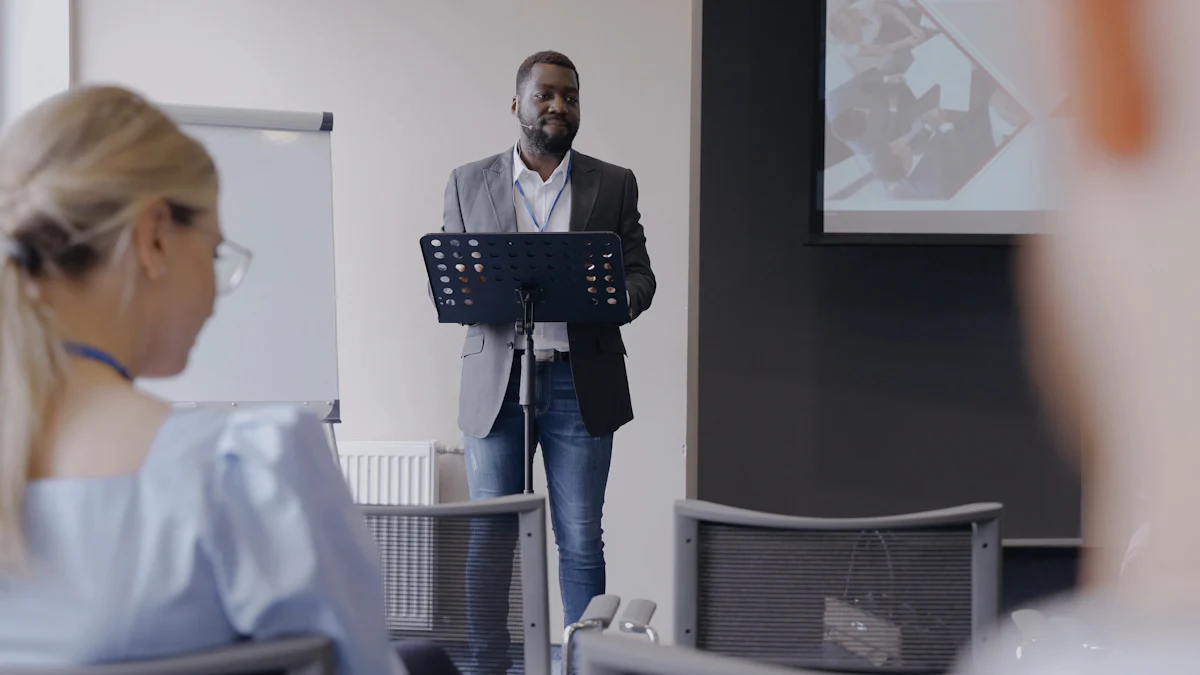Proven Tips to Keep Your Audience Engaged During a Speech

Imagine standing in front of a room full of people, hoping to deliver a speech that leaves a lasting impression. Sounds daunting, right? Keeping your audience engaged is often the trickiest part of public speaking, especially when considering how to engage an audience in a speech. Without that connection, even the most well-prepared presentation can fall flat.
So, how do you make sure your audience stays with you from start to finish? It starts with understanding their needs. People crave a personal connection. They want to feel like you're speaking directly to them. Humor can also work wonders, but only if it feels natural. And let’s not forget the challenge of handling questions effectively—this can make or break your engagement.
By focusing on how to engage an audience in a speech, you can transform your presentation into an experience that resonates. Whether you're addressing a small group or a packed auditorium, these strategies will help you connect, inspire, and leave your audience wanting more.
How to Engage an Audience in a Speech
Know Your Audience
Research their demographics, interests, and expectations.
Before stepping onto the stage, take time to understand who you’ll be speaking to. Knowing your audience is the foundation of audience engagement. Ask yourself: What do they care about? What challenges do they face? By answering these questions, you can shape your message to resonate with them.
Here are some key characteristics to analyze:
- Audience expectations
- Knowledge of the topic
- Attitude toward the topic
- Audience size
- Demographics
To gather this information, use tools that provide valuable insights. For example:
| Tool/Method | Description |
|---|---|
| Google Analytics | Provides insights into audience demographics, geographic location, devices used, and user behavior. |
| Google Trends | Helps identify current interests and popular keywords relevant to your industry or niche. |
| SurveyMonkey | Allows creation of surveys to collect feedback and data on audience preferences and demographics. |
| Social Media Insights | Offers analytics on audience demographics, engagement metrics, and post-performance on social media platforms. |
When you know your audience well, you can craft a presentation that feels personal and relevant. This connection is key to engaging your audience and keeping their attention.
Tailor your message to address their specific needs or challenges.
Once you’ve done your research, use what you’ve learned to shape your message. Think about how your speech can solve a problem or provide value. For example, if you’re speaking to a group of young entrepreneurs, focus on actionable tips for growing a business. If your audience is more experienced, dive into advanced strategies or industry trends.
Tailoring your message shows that you’ve put thought into their needs. It’s not just about delivering information; it’s about making your audience feel seen and understood.
Set Clear Objectives
Define the key takeaways you want your audience to remember.
What do you want your audience to walk away with? Defining your key message is crucial. A clear objective helps you stay focused and ensures your audience remembers the most important points. For instance, if your presentation is about leadership, your key message might be, “Empathy is the cornerstone of effective leadership.”
Keep your objectives simple and specific. Avoid overwhelming your audience with too much information. Instead, focus on one or two key takeaways that align with their priorities.
Align your content with their priorities and concerns.
Your audience will engage more if your content speaks directly to their interests. A great example of this is how Satya Nadella transformed Microsoft’s audience engagement. By prioritizing customer feedback and open communication, he aligned the company’s message with what customers truly cared about. This approach not only improved engagement but also revitalized Microsoft’s reputation.
When you align your content with your audience’s concerns, you show them that their needs matter. This builds trust and keeps them invested in your presentation.
Start Strong to Keep an Audience Engaged

Use a Powerful Opening
Begin with a story, a surprising fact, or a thought-provoking question.
The first few moments of your speech are critical. They set the tone and determine whether your audience will stay engaged. A powerful opening grabs attention and sparks curiosity. You could start with a personal story that connects to your topic. For example, if you're discussing resilience, share a moment when you overcame a challenge. Stories create an emotional connection and make your message relatable.
Another option is to use a surprising fact or statistic. Did you know that 70% of millennials value experiences over material things? This kind of data not only intrigues your audience but also gives them something to think about. You could also ask a thought-provoking question like, "What would you do if you had only 24 hours to achieve your biggest goal?" Questions like this pull your audience into the conversation and make them eager to hear more.
Psychologically, this works because of the "information gap." When you present something intriguing, your audience feels compelled to learn more to fill that gap. This keeps them hooked from the start.
Relate to a recent event or the audience's current experiences.
Tying your opening to something recent or relevant to your audience can make your speech feel timely and relatable. For instance, if you're speaking to event organizers, you might mention how 88% of attendees prioritize networking opportunities at events. Or, if you're addressing a younger crowd, highlight how millennials and Gen Z now make up 42% of the population, reshaping how we connect and communicate.
By referencing trends or shared experiences, you show that you understand your audience's world. This builds an immediate connection and makes your presentation more engaging.
Build Credibility and Connection
Share your expertise or a personal anecdote to establish trust.
Your audience wants to know why they should listen to you. Sharing your expertise or a personal story can establish trust and credibility. For example, if you're a business leader, talk about a time when you faced a tough decision and what you learned from it. This not only highlights your experience but also makes you more relatable.
The "halo effect" explains why this works. When you make a strong first impression, your audience is more likely to view the rest of your presentation positively. By showing your authority early on, you set the stage for a successful speech.
Use humor or reference the setting to create rapport.
Humor is a fantastic tool for building a connection with your audience. A light joke or a funny observation about the setting can break the ice and make everyone feel at ease. For example, if you're speaking at a conference, you might say, "I hope everyone had their coffee this morning—because I know I did!" Humor not only makes your speech more enjoyable but also helps your audience remember your message.
It works because humor engages cognitive processes and makes your points more memorable. Plus, it shows that you're approachable, which encourages your audience to stay engaged throughout your presentation.
Encourage Interaction for Better Audience Engagement

Ask Questions
Pose open-ended or rhetorical questions to spark curiosity.
Questions are a powerful way to involve your audience and keep them thinking. Open-ended questions like, "What would you do if you had unlimited resources to solve this problem?" encourage participation and spark curiosity. Rhetorical questions, on the other hand, make your audience reflect without needing an immediate answer. For example, asking, "Have you ever wondered why some presentations stick while others don’t?" can grab attention and set the stage for your message.
When you ask questions throughout your speech, you create an interactive experience that feels more like a conversation. This approach helps you connect with your audience and makes them care about your presentation.
Use interactive elements like polls or quizzes to involve the audience.
Interactive elements are another great way to foster engagement. Tools like polls and quizzes make your presentation dynamic and interactive. Here’s a quick look at how they work:
| Interactive Element | Description | Engagement Impact |
|---|---|---|
| Quizzes | Engaging users with fun and shareable content. | 96% completion rate for BuzzFeed quizzes. |
| Polls | Quick feedback collection on social media. | Valuable audience insights and preferences. |
| Interactive Videos | Users interact with content through choices or embedded links. | Increases engagement and product views significantly. |
| Shoppable Videos | Allows viewers to click on products within the video for more information. | 30% increase in product views and 15% boost in sales. |
| Interactive Infographics | Visual data representation that encourages user interaction. | Reduces bounce rates and increases time on site. |
Using these elements during your speech can transform a passive audience into active participants. For example, you could ask your audience to vote on a topic or take a quick quiz to test their knowledge. These small actions make them feel involved and keep their attention.
Facilitate Activities
Incorporate group discussions or quick exercises.
Interactive exercises like group discussions can energize your audience. For instance, you could divide them into small groups and ask them to brainstorm solutions to a problem. This not only encourages participation but also helps them connect with each other. Quick exercises, like a two-minute reflection or a show of hands, can also break the monotony and re-engage your audience.
Use role-playing or problem-solving scenarios to engage participants.
Role-playing and problem-solving scenarios are excellent ways to involve your audience. These activities foster creativity and collaboration. They also create a relaxed environment where participants feel comfortable sharing ideas. For example:
- Role play can simulate real-world challenges, helping participants practice communication skills.
- Problem-solving scenarios encourage teamwork and critical thinking.
- These techniques make your presentation more memorable and engaging.
By incorporating these activities, you can foster engagement and leave a lasting impression.
Respond to Feedback
Pay attention to audience reactions and adjust your delivery.
Your audience’s body language can tell you a lot. If you notice signs of disengagement, like slouching or distracted looks, adjust your tone or pace. Sometimes, a quick pause or a light joke can bring their focus back. Paying attention to these cues shows that you value their experience.
Address questions or comments to maintain a two-way dialogue.
Encouraging questions during your presentation can turn it into a dynamic and interactive experience. Open-ended questions, in particular, stimulate thought and allow your audience to express their ideas. This approach not only deepens their connection to your message but also helps you gauge their understanding.
When you address comments or questions, you show that you’re listening. This builds trust and keeps your audience engaged. Without this interaction, you risk a lack of engagement, which can make your speech feel one-sided.
Adapt and Respond to Keep an Audience Engaged
Read the Room
Observe body language and signs of disengagement.
Your audience's body language can reveal a lot about their level of engagement. Are they leaning forward, nodding, or maintaining eye contact? These are great signs. But if you notice slouching, fidgeting, or blank stares, it’s time to adjust. Pay attention to these cues throughout your presentation.
Purposeful movement can also help you connect with different parts of the room. For example, walking closer to a disengaged section can draw their attention back. On the flip side, moments of stillness can emphasize key points and refocus wandering minds. Always ensure your body language matches your message. Mixed signals can confuse your audience and weaken your impact.
Adjust your tone, pace, or content to re-capture attention.
When you sense your audience drifting, tweak your delivery. A simple pause can work wonders. It gives your listeners a moment to process what you’ve said and builds anticipation for what’s next. Varying your speed also keeps things interesting. Slow down for important points and pick up the pace during lighter moments.
Adapting to the room’s energy is another effective strategy. If the atmosphere feels flat, inject some enthusiasm into your tone. Rehearsing your speech beforehand helps you instinctively adjust your pacing during the live presentation. These small changes can make a big difference in keeping your audience engaged.
Handle Questions Effectively
Encourage questions at appropriate times during the presentation.
Questions are a fantastic way to foster interaction and gauge your audience’s understanding. Start with simple ones, like asking for a show of hands, to break the ice. Gradually move to more thought-provoking questions that encourage deeper reflection. For example, “What’s one challenge you’ve faced in this area?” invites participation and sparks meaningful dialogue.
Timing is key. Encourage questions at natural pauses in your presentation, such as after explaining a complex idea. This keeps the flow smooth and ensures everyone stays on track. Tailor your questions to your audience’s interests to make them feel involved and valued.
Provide clear answers and acknowledge audience contributions.
When someone asks a question, listen actively and respond with clarity. Keep your answers concise and relevant to the topic. If possible, use a brief story or example to illustrate your point. This not only clarifies your response but also keeps the rest of the audience engaged.
Always acknowledge the person who asked the question. A simple “That’s a great question” or “Thanks for bringing that up” shows appreciation and encourages others to participate. Address the entire room when answering to maintain inclusivity. By handling questions with enthusiasm and respect, you create an open and engaging atmosphere.
Engaging your audience during a speech doesn’t have to feel overwhelming. Let’s recap the key strategies that can transform your presentation into an unforgettable experience:
| Strategy | Description |
|---|---|
| Storytelling frameworks | Keeps your audience invested from start to finish. |
| Fostering interaction | Actively involves your audience, making them part of the presentation. |
| Maintaining eye contact | Builds a connection and keeps your audience focused. |
| Using body language | Enhances communication and conveys confidence. |
| Managing voice | Captivates your audience through vocal variety and emphasis. |
| Structuring presentations | Organizes content logically to facilitate understanding and retention. |
Remember, audience engagement is a skill that grows with practice. The more you prepare and refine your speaking techniques, the better you’ll connect with your audience. Whether you’re delivering a speech to a small group or presenting to a packed room, these strategies will help you leave a lasting impression.
So, why wait? Apply these tips in your next presentation and see the difference for yourself. Strong audience engagement doesn’t just make your speech memorable—it builds trust, fosters relationships, and ensures your message truly resonates.
FAQ
How can I make my audience feel more connected during a presentation?
Focus on storytelling and personal anecdotes. Share experiences that relate to your audience's challenges or interests. Use humor or references to their current experiences. This approach builds trust and makes your presentation feel more personal.
What should I do if I notice my audience losing interest?
Pay attention to their body language. Adjust your tone, pace, or content to re-capture their attention. You can also ask a question or share an engaging story to bring the focus back to your presentation.
How do I handle difficult questions during a presentation?
Stay calm and listen carefully. Acknowledge the question and provide a clear, concise answer. If you don’t know the answer, admit it and offer to follow up later. This honesty builds credibility with your audience.
What’s the best way to encourage audience participation?
Ask open-ended questions or use interactive tools like polls and quizzes. Facilitate group discussions or quick exercises. These methods make your audience feel involved and keep them engaged throughout your presentation.
How can I ensure my key points are remembered after the presentation?
Define clear objectives and repeat your key takeaways at the end. Use visuals or memorable stories to reinforce your message. A strong conclusion leaves a lasting impression on your audience.
See Also
10 Effective Strategies for Engaging Audiences at Events
10 Ways to Enhance Audience Interaction Using Zoom
7 Key Approaches to Foster Emotional Bonds with Audiences
